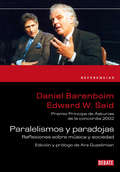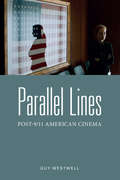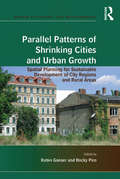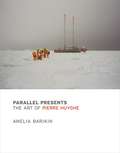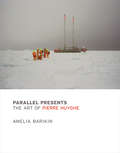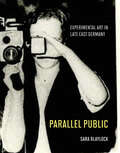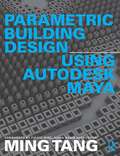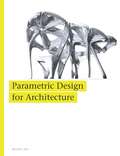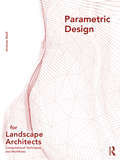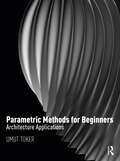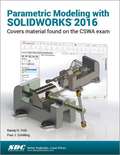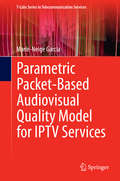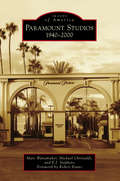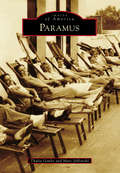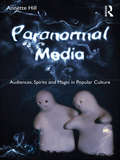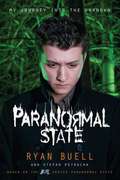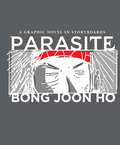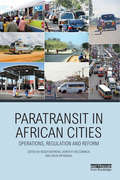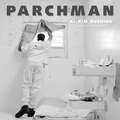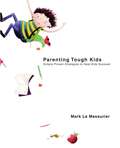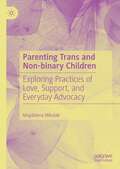- Table View
- List View
Paralelismos y paradojas
by Edward W. Said Daniel BarenboimEl israelí Daniel Barenboim -director de la orquesta Sinfónica de Chicago y de la Ópera Estatal de Berlín- y el palestino-noreteamericano Edward Said -eminente crítico literario y comprometido analista del conflicto de Oriente Próximo- han cultivado desde hace muchos años una profunda amistad que se hace patente en el apasionado y cordial intercambio de ideas que tiene lugar en estas conversaciones.Barenboim y Said hablan, entre otras cuestiones, de las diferencias entre la escritura de prosa y la de la música, de políticos que tratan de llegar a acuerdos y de artistas que sólo se comprometen con su arte, del famoso director Furtwängler, de Beethoven como supremo compositor de sonatas, de Wagner, de maestros y discípulos y, sobre todo, del poder de la cultura para ir más allá de las barreras nacionales y las diferencias políticas.Paralelismos y paradojas es un libro de ideas originales y sorprendentes sobre música, política y cultura que despliega un derroche de inteligencia de dos grandes mitos de nuestra cultura contemporánea.
Parallel Lines
by Guy WestwellParallel Lines describes how post-9/11 cinema, from Spike Lee's 25th Hour (2002) to Kathryn Bigelow's Zero Dark Thirty (2012), relates to different, and competing, versions of US national identity in the aftermath of the September 11th terrorist attacks. The book combines readings of individual films (World Trade Center, United 93, Fahrenheit 9/11, Loose Change) and cycles of films (depicting revenge, conspiracy, torture and war) with extended commentary on recurring themes, including the relationship between the US and the rest of the world, narratives of therapeutic recovery, questions of ethical obligation.The volume argues that post-9/11 cinema is varied and dynamic, registering shock and upheaval in the immediate aftermath of the attacks, displaying capacity for critique following the Abu Ghraib prisoner abuse scandal mid-decade, and seeking to reestablish consensus during Obama's troubled second term of office.
Parallel Lines: Post-9/11 American Cinema
by Guy WestwellDescribes how post-9/11 cinema, from Spike Lee's 25th Hour (2002) to Kathryn Bigelow's Zero Dark Thirty (2012), relates to different, and competing, versions of US national identity in the aftermath of the September 11th terrorist attacks
Parallel Lines: Post-9/11 American Cinema
by Guy WestwellParallel Lines describes how post-9/11 cinema, from Spike Lee's 25th Hour (2002) to Kathryn Bigelow's Zero Dark Thirty (2012), relates to different, and competing, versions of US national identity in the aftermath of the September 11 terrorist attacks. The book combines readings of individual films (World Trade Center, United 93, Fahrenheit 9/11, Loose Change) and cycles of films (depicting revenge, conspiracy, torture and war) with extended commentary on recurring themes, including the relationship between the US and the rest of the world, narratives of therapeutic recovery, questions of ethical obligation.The volume argues that post-9/11 cinema is varied and dynamic, registering shock and upheaval in the immediate aftermath of the attacks, displaying capacity for critique following the Abu Ghraib prisoner abuse scandal mid-decade, and seeking to reestablish consensus during Obama's troubled second term of office.
Parallel Patterns of Shrinking Cities and Urban Growth: Spatial Planning for Sustainable Development of City Regions and Rural Areas (Urban Planning And Environment Ser.)
by Rocky PiroFocussing particularly on urban fringe and rural areas, this book addresses the parallel phenomena of growth and decline. In doing so, it not only broadens a debate which generally concentrates on urban municipalities, especially inner city areas, but also covers new ground by starting to build a new theoretical framework for the spatial planning related assessment of these phenomena. Bringing together contributions from internationally renowned authors, such as Sir Peter Hall, Steve Ward and Johann Jessen, the book compares international case studies and highlights their relationships with one another. It concludes by emphasizing common themes that are addressed, as well as showing applicability to other urban and rural regions. Overall, the book provides a timely and comprehensive analysis of the spatial consequences and related spatial planning concepts in theory and practice which aim to further sustainable development of city regions, urban fringe and rural areas experiencing growth and decline.
Parallel Presents
by Amelia BarikinOver the past two decades, French artist Pierre Huyghe has produced an extraordinary body of work in constant dialogue with temporality. Investigating the possibility of a hypothetical mode of timekeeping--"parallel presents"-- Huyghe has researched the architecture of the incomplete, directed a puppet opera, founded a temporary school, established a pirate television station, staged celebrations, scripted scenarios, and journeyed to Antarctica in search of a mythological penguin. In this first book-length art historical examination of Huyghe and his work, Amelia Barikin traces the artist's continual negotiation with the time codes of contemporary society. Offering detailed analyses of Huyghe's works and drawing on extensive interviews with Huyghe and his associates, Barikin finds in Huyghe's projects an alternate way of thinking about history--a "topological historicity" that deprograms (or reprograms) temporal formats. Huyghe once said, "It is through the montage, the way we combine and relate images, that we can create a representation of an event that is perhaps more precise than the event itself. "Barikin offers pioneering analyses of Huyghe's lesser-known early works as well as sustained readings of later, critically acclaimed projects, including No Ghost Just a Shell (2000), L'Expédition scintillante (2002), and A Journey That Wasn't (2005). She emphasizes Huyghe's concepts of "freed time" and "the open present," in which anything might happen. Bringing together an eclectic array of subjects and characters--from moon walking to situationist practices, from Snow White to Gilles Deleuze-- Parallel Presents offers a highly original account of the driving forces behind Huyghe's work
Parallel Presents: The Art of Pierre Huyghe
by Amelia BarikinThe first book-length art historical examination of a major contemporary French artist.Over the past two decades, French artist Pierre Huyghe has produced an extraordinary body of work in constant dialogue with temporality. Investigating the possibility of a hypothetical mode of timekeeping—“parallel presents”—Huyghe has researched the architecture of the incomplete, directed a puppet opera, founded a temporary school, established a pirate television station, staged celebrations, scripted scenarios, and journeyed to Antarctica in search of a mythological penguin. In this first book-length art historical examination of Huyghe and his work, Amelia Barikin traces the artist's continual negotiation with the time codes of contemporary society. Barikin finds in Huyghe's projects an alternate way of thinking about history—a “topological historicity” that deprograms (or reprograms) temporal formats. Barikin offers pioneering analyses of Huyghe's lesser-known early works as well as sustained readings of later, critically acclaimed projects, including No Ghost Just a Shell (2000), L'Expédition scintillante (2002), and A Journey That Wasn't (2005). She emphasizes Huyghe's concepts of “freed time” and “the open present,” in which anything might happen. Bringing together an eclectic array of subjects and characters—from moon walking to situationist practices, from Snow White to Gilles Deleuze—Parallel Presents offers a highly original account of the driving forces behind Huyghe's work.
Parallel Public: Experimental Art in Late East Germany
by Sara BlaylockHow East German artists made their country&’s experimental art scene a form of (counter) public life.Experimental artists in the final years of the German Democratic Republic did not practice their art in the shadows, on the margins, hiding away from the Stasi&’s prying eyes. In fact, as Sara Blaylock shows, many cultivated a critical influence over the very bureaucracies meant to keep them in line, undermining state authority through forthright rather than covert projects. In Parallel Public, Blaylock describes how some East German artists made their country&’s experimental art scene a form of (counter) public life, creating an alternative to the crumbling collective underpinnings of the state. Blaylock examines the work of artists who used body-based practices—including performance, film, and photography—to create new vocabularies of representation, sharing their projects through independent networks of dissemination and display. From the collective films and fashion shows of Erfurt's Women Artists Group, which fused art with feminist political action, to Gino Hahnemann, the queer filmmaker and poet who set nudes alight in city parks, these creators were as bold in their ventures as they were indifferent to state power. Parallel Public is the first work of its kind on experimental art in East Germany to be written in English. Blaylock draws on extensive interviews with artists, art historians, and organizers; artist-made publications; official reports from the Union of Fine Artists; and Stasi surveillance records. As she recounts the role culture played in the GDR&’s rapid decline, she reveals East German artists as dissenters and witnesses, citizens and agents, their work both antidote to and diagnosis of a weakening state.
Parametric Building Design Using Autodesk Maya
by Ming TangDue to its comprehensive tool-set and great potential for 3D modeling, more and more architectural design and interior design firms are adapting Autodesk Maya and integrating it into their practice. There has been no book aimed at architects and designers who wish to harness the opportunities presented by this software, until now..... The book promotes parametric design. It integrates the theoretical research of computational design and Maya non-linear modeling techniques associated with simulation, animation, digital fabrication and form-finding within 2D & 3D design. Readers will learn: How to use Maya polygon and NURBS modeling tools to create non-linear procedural model. How to use Maya driver keys and relationship tools to generate parametrically negotiable solutions across various design professions. The design logic and generative processes, as well as the potential of parametric thinking as a resourceful tool for achieving diversity and complexity in form generation and fabrication. How to use Maya to prepare files for rapid prototyping and the integration of Maya into various fabrication techniques such as laser cutting, CNC milling, and 3D printing. How to create a digital simulation to simulate all aspects of surface properties and dynamic forces with Maya physics engine. How to use Maya skeleton system and animation tools to control complex architectural forms. How to create photo-realistic renderings with Maya lighting, material and texture mapping. Using several real projects as examples, the book will go through the entire rendering process step by step. How to combine Maya with various CAD/BIM tools to create an efficient design pipeline. How to use Maya MEL script to create customized tools and interface. The book includes case studies from Zaha Hadid Architects, Greg Lynn Form, Gage Clemenceau Architects, Tang & Yang Architects, as well as step by step exercises, demonstration projects and crucially a fantastic online resource which includes video tutorials, scripts, and Maya source files.
Parametric Design for Architecture
by Wassim JabiArchitects use CAD to help them visualize their ideas. Parametric design is a fast-growing development of CAD that lets architects and designers specify the key parameters of their model and make changes interactively. Whenever changes are made the rest of the model updates automatically.Through a detailed description of various parametric, generative and algorithmic techniques, this book provides a practical guide to generating geometric and topological solutions for various situations, including explicit step-by-step tutorials. While the techniques and algorithms can be generalized to suit to any parametric environment, the book illustrates its concepts using the scripting languages of one of the most powerful 3D visualization and animation design software systems (Autodesk 3ds Max MAXScript), one of the most popular open-source Java-based scripting environments (Processing), and a brand new language specifically tailored for parametric and generative design (Autodesk DesignScript).This clear, accessible book will have a wide appeal to students and practitioners who would like to experiment with parametric techniques.
Parametric Design for Architecture
by Wassim JabiArchitects use CAD to help them visualize their ideas. Parametric design is a fast-growing development of CAD that lets architects and designers specify the key parameters of their model and make changes interactively. Whenever changes are made the rest of the model updates automatically.Through a detailed description of various parametric, generative and algorithmic techniques, this book provides a practical guide to generating geometric and topological solutions for various situations, including explicit step-by-step tutorials. While the techniques and algorithms can be generalized to suit to any parametric environment, the book illustrates its concepts using the scripting languages of one of the most powerful 3D visualization and animation design software systems (Autodesk 3ds Max MAXScript), one of the most popular open-source Java-based scripting environments (Processing), and a brand new language specifically tailored for parametric and generative design (Autodesk DesignScript).This clear, accessible book will have a wide appeal to students and practitioners who would like to experiment with parametric techniques.
Parametric Design for Landscape Architects: Computational Techniques and Workflows
by Andrew MadlParametric Design for Landscape Architects provides a sequence of tutorial-based workflows for the creation and utilization of algorithmic tools calibrated toward the field of landscape architecture. Contemporary practice and projective theory in landscape architecture require the processing and design of data associated with complex systems to adequately represent composite, emergent scenarios. Aligning to both traditional and nascent processes of analysis and digital modeling, this book unpacks and decodes the characterization of algorithmic-based automation, leveraging software that is widely accessible in both academia and professional practice. Curated throughout are workflows that apply to a multiplex of computation programs that widely support the design, analysis, and production of landscapes, primarily concentrated on digital modeling tools Grasshopper and Rhinoceros. It is a much-needed, visually accessible resource to aid in more efficient understanding and creation of tools that automate and re-examine traditional calculations, analyses, drawing standards, form-finding strategies, fabrication preparations, and speculative assessments/simulation. This primer provides professionals and students with multifaceted skill-sets that, when applied in practice, expand and expedite conventional and speculative design workflows applicable to spatial design, and more specifically landscape architecture. The book includes over 200 full-colour drawings, images, and tables to illustrate and support examples throughout.
Parametric Methods for Beginners: Architecture Applications
by Umut TokerThis book introduces architectural applications of parametric methods in design, drawing direct connections between each phase of the architectural design process with relevant parametric approaches. Readers will find applications of parametric methods with straightforward explanations of concepts, commands as well as applicable examples for each phase of the architectural design process. In addition to learning about the historical and conceptual background of parametric design, readers can use this book as a go-to source during their day-to-day design practice. Chapters are organized according to different phases of the architectural design process, such as site analysis, spatial organization, skin systems, and environmental performance analyses. Together, they deliver concepts, applications, and examples utilizing in-depth visual guides that explain commands, their outcomes, and their interrelationships. With over 350 images, this book includes examples from the author’s own design studio and parametric design teaching in elective classes. Based on the Rhinoceros and Grasshopper platforms, this book is an accessible, yet in-depth, resource for architecture students and early professionals who are considering integrating parametric applications into their design processes.
Parametric Modeling with SOLIDWORKS 2016
by Randy H. Shih Paul J. Schilling<p>Parametric Modeling with SOLIDWORKS 2016 contains a series of sixteen tutorial style lessons designed to introduce SOLIDWORKS 2016, solid modeling and parametric modeling techniques and concepts. This book introduces SOLIDWORKS 2016 on a step-by-step basis, starting with constructing basic shapes, all the way through to the creation of assembly drawings and motion analysis. <p>This book takes a hands on, exercise intensive approach to all the important Parametric Modeling techniques and concepts. Each lesson introduces a new set of commands and concepts, building on previous lessons. The lessons guide the user from constructing basic shapes to building intelligent solid models, assemblies and creating multi-view drawings. <p>This book also covers some of the more advanced features of SOLIDWORKS 2016, including how to use the SOLIDWORKS Design Library, basic motion analysis, collision detection and analysis with SimulationXpress. <p>The exercises in this book cover the performance tasks that are included on the Certified SOLIDWORKS Associate (CSWA) Examination. Reference guides located at the front of the book and in each chapter show where these performance tasks are covered.</p>
Parametric Packet-based Audiovisual Quality Model for IPTV services
by Marie-Neige GarciaThis volume presents a parametric, packet-based, comprehensive model to measure and predict the audiovisual quality of Internet Protocol Television services as it is likely to be perceived by the user. The comprehensive model is divided into three sub-models referred to as the audio model, the video model, and the audiovisual model. The audio and video models take as input a parametric description of the audiovisual processing path, and deliver distinct estimates for both the audio and video quality. These distinct estimates are eventually used as input data for the audiovisual model. This model provides an overall estimate of the perceived audiovisual quality in total. The parametric description can be used as diagnostic information. The quality estimates and diagnostic information can be practically applied to enhance network deployment and operations. Two applications come to mind in particular: Network planning and network service quality monitoring. The audio model can be used indifferently for both applications. However, two variants of the video model have been developed in order to address particular needs of the applications mentioned above. The comprehensive model covers effects due to resolution, coding, and IP-packet loss in case of RTP-type transport. The model applied to quality monitoring is standardized under the ITU-T Recommendations P. 1201 and P. 1201. 2.
Paramount Studios: 1940-2000 (Images of America)
by Robert Evans Marc Wanamaker E. J. Stephens Michael ChristaldiThe fascinating tale of Hollywood powerhouse Paramount Pictures--beginning with its birth in the 1910s through the turbulent decade of the 1930s--was told in Early Paramount Studios by Marc Wanamaker, Michael Christaldi, and E.J. Stephens. Now the same authors are back to tell the next 60 years of the studio saga in Paramount Studios: 1940-2000, with a foreword by former Paramount head of production Robert Evans. This book picks up the story during the time of World War II--a successful era for the studio--which was followed by a decade of decline due to the upstart medium of television. By the 1960s, the studio teetered on the brink of bankruptcy before rebounding, thanks to several 1970s blockbusters, such as Love Story, The Godfather, and Chinatown. The tale continues through the final decades of the 20th century when Paramount showcased some of the greatest hits in its history.
Paramount: City of Dreams
by Steven BingenParamount: City of Dreams brings to life the operations of the world&’s grandest movie lot as never before by opening its famous gates and revealing – for the first time – the wonderful myriad of soundstages and outdoor sets where, for one hundred years, Paramount has produced the world&’s most famous films. With hundreds and hundreds of rare and unpublished photographs in color and black & white, readers are launched aboard a fun and entertaining &“virtual tour&” of Hollywood&’s first, most famous and most mysterious motion picture studio. Paramount is a self-contained city. But unlike any community in the real world, this city&’s streets and lawns, its bungalows and backlots, will be familiar even to those who have never been there. Now, for the first time, these much-filmed, much-haunted acres will be explored and the mysteries and myths peeled away – bringing into focus the greatest of all of Hollywood&’s legendary dream factories.
Paramus
by Thalia Goulis Marc JablonskiLocated in central Bergen County, the vibrant borough of Paramus has been home to many people and cultures. Today, this suburb of New York City is a nationally distinguished shopping destination, but less than a century ago, it was almost entirely farmland. The Sprout Brook, which still runs alongside Route 17, divided the area into two distinct farming regions, one of which was responsible for the town's reputation as "the Celery Capital of the World." In 1922, Paramus branched off from Midland Township, transforming into its own prosperous community. An attraction at that time was the Bergen Pines Hospital, which initially put the town on the map. Other local attractions included the Arcola Amusement Park, eventually lost to a fire, as well as Paramus Lanes and the Paramus Skating Rink. In 1957, the Garden State Plaza opened, and by 1961, it had become one of the largest shopping malls in the country. Paramus showcases the rich community heritage of this Bergen County borough.
Paranormal Media: Audiences, Spirits and Magic in Popular Culture
by Annette HillThe paranormal has gone mainstream.Beliefs are on the rise, with almost half of the British population, and two thirds of Americans, claiming to believe in extra sensory perceptions and hauntings. Psychic magazines like Spirit and Destiny, television shows such as Fringe, Ghost Whisperer and Most Haunted, ghost-cams and e-poltergeists, bestselling books on mind, body and spirit, and magicians like Derren Brown have moved from the outer limits to the centre of popular culture, turning paranormal beliefs and scepticism into revenue streams.Paranormal Media offers a unique, timely exploration of the extraordinary, unexplained and supernatural in popular culture, looking in unusual places in order to understand this phenomenon. Early spirit forms such as magic lantern shows or the spirit photograph are re-imagined as a search for extraordinary experiences in reality TV, ghost tourism, and live shows. Through a popular cultural ethnography, and critical analysis in social and cultural theory, this ground-breaking book by Annette Hill presents an original and rigorous examination of people's experiences of spirits and magic. In popular culture, people are players in an orchestral movement about what happens to us when we die. In a very real sense the audience is the show. This book is the story of audiences and their participation in a show about matters of life and death.Paranormal Media will be a highly interesting read for undergraduate and postgraduate students, as well as academics, on a wide range of television, media, cultural studies, and sociology courses.
Paranormal State: My Journey into the Unknown
by Stefan Petrucha Ryan BuellParanormal State: My Journey Into the Unknown is the official companion book to A&E’s hit series.On every episode of Paranormal State, Ryan Buell and his team of investigators delve deep into the mysterious world of ghosts, demonic disturbances, and sixth-sense sightings that shadows our everyday reality. Now, in this guide to the series, Buell takes fans one step further, revealing the secrets of the show’s most intense cases—as well as some that were never broadcast—and the shocking, never-before-told story of his own brush with the supernatural—the otherworldly experience that first inspired him to found the Paranormal Research Society.And with each case of unexplained phenomena, Ryan shares how the events forced him to confront his own beliefs, the workings of his rational mind, and the very nature of reality.
Parasite: A Graphic Novel in Storyboards
by Bong Joon HoDiscover the illustrations that inspired the historic, OSCAR®-winning film's every shot in this graphic novel drawn by Director Bong Joon Ho himself. So metaphorical: With hundreds of mesmerizing illustrations, Parasite: A Graphic Novel in Storyboards is a behind-the-scenes glimpse at the making of one of the best films in years and a brand-new way to experience a global phenomenon. As part of his unique creative process, Director Bong Joon Ho storyboarded each shot of PARASITE prior to the filming of every scene. Accompanied by the film's dialogue, the storyboards he drew capture the story in its entirety and inspired the composition of the film's every frame and scene. Director Bong has also written a foreword and provided early concept drawings and photos from the set, which take the reader even deeper into the vision that gave rise to this stunning cinematic achievement. Director Bong's illustrations share the illuminating power of his writing and directing. The result is a gorgeous, riveting read and a fresh look at the vertiginous delights and surprises of Bong Joon Ho's deeply affecting, genre-defying story. <P><P> <i>Advisory: Bookshare has learned that this book offers only partial accessibility. We have kept it in the collection because it is useful for some of our members. Benetech is actively working on projects to improve accessibility issues such as these.</i>
Paratransit in African Cities: Operations, Regulation and Reform
by Roger Behrens Dorothy McCormick David MfinangaPublic transport systems in contemporary Sub-Saharan African cities are heavily reliant upon paratransit services. These services are defined as informal transportation which operates between the public and individual private spheres. In Africa paratransit is characterized by low quality of vehicles and chaotic management but it also provides cheap, accessible and flexible transport solutions for the urban poor. It is typically poorly regulated and operates as a set of informal businesses. A common result of weak public sector regulation and a fare strategy in which owners claim a fixed daily revenue target and drivers who keep the variable balance as income, is destructive competition and poor quality of service. There is an incontrovertible case for improving the quality, reliability and coverage of public transport systems, and some city governments have attempted to do so by initiating reform projects that envisage the phased replacement of paratransit operations with formalised bus rapid transit systems. In this book the authors argue that there are, however, path dependencies and constraints that limit the possible extent of public transport system reform. Paratransit operations also have some inherent advantages with respect to demand responsiveness and service innovation. Attempts to eradicate paratransit may be neither pragmatic nor strategic. Two future scenarios are likely: hybrid systems comprised of both paratransit and formally planned modes; and systems improved by upgrades and strengthened regulation of existing paratransit services. The business strategies and aspirations of incumbent paratransit operators in three case cities – Cape Town, Dar es Salaam and Nairobi – are discussed, as well as their attitudes towards emerging public transport reform projects. International experiences of hybrid system regulation and paratransit business development are reviewed in order to explore policy options. The authors contend that policies recognising paratransit operators, and seeking contextually appropriate complementarity with formalised planned services, will produce greater benefits than policies ignoring their continued existence.
Parchman
by R. Kim RushingConstructed in 1904, the Mississippi State Penitentiary at Parchman covers 20,000 acres, forty-six square miles, in the heart of the Mississippi Delta. Originally designed like a private plantation without walls or guard towers, the prison farm has been slowly transformed over the decades into a modern penitentiary. In 1994, photographer R. Kim Rushing was the first outside photographer in Parchman's history allowed long-term access to inmates and the chance to photograph them in their cells and living quarters after earning great trust with his subjects. In Parchman he offers a glimpse of the men incarcerated in this infamous place. Eighteen volunteer inmates, ranging in custody level from trusty to death row, are presented through images and their own handwritten letters. When Rushing started this work, he brought visceral, human questions. What is it like to be an inmate in Parchman Penitentiary? What happens to an individual there? How does it happen? How do the prisoners feel about their circumstances? What does it feel like when two people from completely different worlds look at each other over the top of a camera? Moving to Ruleville, Mississippi, a small town in the heart of the Delta, Rushing came face to face with the influence of Parchman State Penitentiary. After becoming known in the area, he was allowed to photograph inmates for almost four years. These men volunteered and permitted him to photograph them in their cells. They even shared their written thoughts about their lives and prison conditions. It is particularly fascinating to see the visible change, or lack thereof, that becomes obvious when viewing portraits separated by two or three years. These stark, moving portraits of prisoners attest to the impact of photography. The photos are accompanied by the prisoners' stories, told in their own words. Together the images and words provide the most complete understanding of Parchman ever published.
Parenting Tough Kids: Simple Proven Strategies to Help Kids Succeed
by Mark Le MessurierParenting Tough Kids delivers simple, proven strategies to improve the behavior, organization, learning, and emotional well-being of all children.Parents will find case studies and practical ideas to help youngsters improve memory and organization, complete homework and chores more easily, deal with school bullies, build emotional resilience, and create healthy friendships.
Parenting Trans and Non-binary Children: Exploring Practices of Love, Support, and Everyday Advocacy
by Magdalena MikulakBased on interviews conducted with parents of trans and gender diverse children in the UK, this book presents an account and analysis of the love, support, and advocacy involved in parenting trans and gender diverse children. Mikulak explores how parents negotiate and challenge cis-normativity to make familial, educational, and healthcare settings livable for their trans and gender diverse children. By examining the educational and emotional labor that parents perform as they advocate for their children across these different settings, the book highlights the value of parental expertise and labor while calling out the systemic failures that continue to make this work necessary. This research will be of interest to scholars researching family studies, kinship studies, gender studies, and queer studies.
